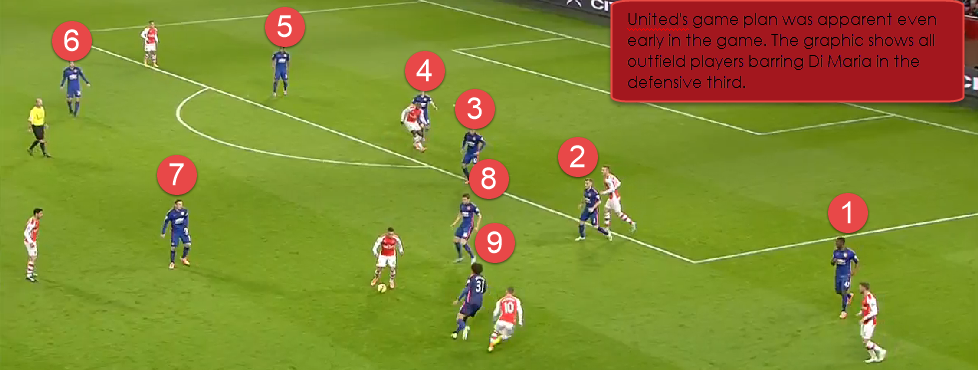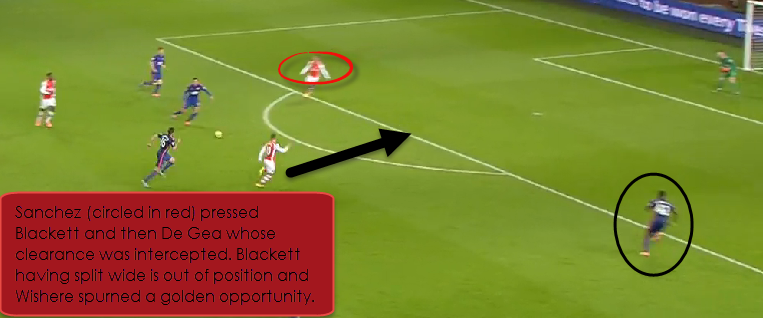Arsenal 1-2 Manchester United: The rivalry between the 2 sides is not the same as it was in the mid-noughties when flying food and tunnel skirmishes dominated the back pages long after the battle took place on the pitch. The rivalry may have toned down since but coming on the back of the international break, both sides were looking for a much needed win to move up the table. Injuries have had a big part to play in both sides’ campaigns and defensive frailties for the teams meant fans and neutrals alike were expecting a game high on entertainment if not quality.
Arsenal: (4-3-3) 1. Szczesny (Martinez, 59′); 21. Chambers, 4. Mertesacker, 18. Monreal, 3. Gibbs; 23. Wilshere (Cazorla, 55′),8. Arteta, 16. Ramsey (Giroud, 77′); 15. Oxlade-Chamberlain, 23. Welbeck, 17. Sanchez.
Manchester United: ( 3-4-1-2) 1. De Gea; 33. McNair, 12. Smalling, 42. Blackett; 25. Valencia, 31. Fellaini, 16. Carrick, 3. Shaw (Young, 16′); 10. Rooney, 20. Van Persie (Wilson, 75”), 7. Di Maria.
Goals: Giroud (90+4′) – Gibbs OG (56′), Rooney (85′)
Van Gaal opting to switch to 3 at the back seeking security in numbers
Manchester United’s well documented injury troubles continued to plague them as midfield mainstay Daley Blind picked up an injury while playing for the Dutch national side. With the likes of Phil Jones, Jonny Evans, and Marcos Rojo missing and devoid of the cover that Blind usually provides in front of the back line, Van Gaal had a decision to make as to how he would set up against Arsenal at the Emirates. With the inexperienced duo of Paddy McNair and Tyler Blackett along with a returning Chris Smalling, who had served a one game ban for his red card and general sheer idiocy against Manchester City, at the Dutchman’s disposal, he switched back to the 3-4-1-2 formation deployed earlier in the season. The pros of such a switch were quite apparent. The 3 man defence with the wing-backs tucked in when needed provided a weak United defence with protection in terms of numbers. Thus, the system was meant to provide reinforcement in the defensive third, let Arsenal dominate the play in terms of possession and territory, and hit them on the break with quick offensive transitions to exploit Arsenal’s tendency to over commit men in the attack.
The graphic above shows how United were set-up on numerous occasions in the first half. All outfield players barring Di Maria are in the defensive third in an attempt to choke Arsenal and stop any interplay between their attacking players in the final third. Although United were lucky to not concede in the first half, most of their problems were issues borne out of their own inability to play the ball out under the pressure of the Arsenal pressing game and the space in behind the defence on transitions (more on those two later). From situations such as the above though, when Arsenal attempted to play through the United defence, the away side held their ground and defended relatively well when Arsenal tried to construct a move.
Arsenal’s pressing and United’s inability to play the ball out of defence
One of the issues United faced with this shape early in the season was that the 3 centre-backs were poor in possession when it came to playing the ball out from defence and this game was no different. In Sanchez, Welbeck, and Oxlade-Chamberlain, Arsenal not only had pacy forwards but also players who were willing to put in a shift off the ball and make life difficult for the opposing defenders. Thus, it came as no surprise that Arsenal were quick to pressurize the United defenders when they tried to play out from the back. It must be said that all the defenders and indeed the otherwise excellent David de Gea struggled to clear their lines. The below graphic shows the number of ball recoveries in the United half throughout the game, undoubtedly far too many for Van Gaal’s liking.

Ball recoveries by Arsenal in the United half. Via Four Four Two’s Statszone
The below graphic shows Arsenal’s pressing scheme. With 3 at the back, the 2 wide centre-backs split and in theory playing out from the back is an advantage gained from usage of this system. However, with Sanchez, Welbeck, and Oxlade-Chamberlain within proximity of the 3 centre-backs and Ramsey close enough to try and cut off the pass to Carrick (out of the frame), the ball invariably found its way back to De Gea. The Spaniard had an excellent game in goal but his distribution was a bit wayward and Arsenal carved out numerous opportunities by the virtue of this but were unable to make any of them count.
Indeed Arsenal’s best chance of the game was a result of their pressing. Sanchez was quick to press both Blackett and De Gea eventually forcing the clearance to fall to an Arsenal man in United’s half. In the meanwhile, Blackett having moved wide to receive the ball is out of position as shown below and can do nothing to stop Wilshere. The England International on his part really should’ve done better after being put through on goal. Arsenal’s wastefulness in front of goal though would be the theme of a frustrating display for the home side.
Arsenal fail to exploit space in behind the United defence
While United got men behind the ball when Arsenal took time to transition from defence to offence, they looked vulnerable when Arsenal tried a more direct route. Playing a high line in general is dangerous if not coordinated properly. To their credit, despite the collective inexperience of the central defensive trio the communication wasn’t the worst. The problem was that as mentioned before the likes of Sanchez, Oxlade-Chamberlain, and Welbeck have pace to burn. The graphic below shows Ramsey running from deep having not been picked up by either Carrick or Fellaini. On this occasion, the ball over the top from Sanchez was a bit over hit and the chance came to nothing.
The above situation was not an isolated incident by any means. Once again it is Sanchez who has occupied a deeper position and plays a lovely through ball to find the run of Oxlade-Chamberlain. He tried to round the keeper but De Gea was up to the task once again. From an Arsenal point of view, it is a shame that Theo Walcott missed the game. Oxlade-Chamberlain put in a good performance and was a threat throughout the game but with the United defence maintaining a high line and with Sanchez’s vision and ability to produce defence splitting passes, Walcott’s pacy diagonal runs in behind the defence could well have been a useful asset for Wenger’s men.
Giroud’s late strike turned out to be nothing but a consolation but it came as no surprise that it came from a ball in behind the United defence. Arteta played the ball over the top and Giroud did the rest with a sweet strike giving the home side a glimmer of hope. It was too little too late though as Manchester United came away with the 3 points.
United make Arsenal pay as the home side loses their shape in search of the equalizer
It was the case of same old, same old for Arsenal. The first part of the narrative was to dominate proceedings and being incredibly wasteful in front of goal before conceding against United. The second part involved over-committing men in search of an equalizer and losing all shape in doing so. Consider the below graphic. The full-backs have been caught up the field and having lost possession are nowhere near the ball. The 3-on-3 situation simply does not bode well for Arsenal. Di Maria, Rooney, and Van Persie against Mertesacker, Arteta, and Monreal isn’t an ideal situation for Arsenal by any means. However, in search of an equalizer the losing side has to throw the much famed kitchen sink at their opponents, and getting caught out on the break is a natural by-product. The only problem is that the below graphic is a screen grab from the 60th minute! With half an hour to go and only 1-0 down, throwing caution into the wind and over-committing men to this degree is extremely naive.
Yes, going behind warrants a response but a balance must be maintained. Especially in big games such as this. With the likes of Rooney, van Persie, and especially di Maria are more than proficient in attack, United had the ammunition to make Arsenal pay. Di Maria with his direct style and seemingly endless energy isn’t a player that you want running at your last line of defence. The above situation may have been salvaged courtesy a bad offside call from the linesman. The point though remains that when only 1-0 down with more than half an hour to go, how does a team find itself in such a situation. Get caught out in this manner late in the game and it’s a different matter. As such, there seems to be a simple template for beating Arsenal. Keep them out for long enough and they will provide you with opportunities later in the game as they lose their shape.
Where does this leave them?
Arsenal are in a poor run of form and they need to snap out of it quickly. They have injury problems of their own and the sooner they’re restored to full strength the better. The frustration around the Emirates is not undue but with Arsenal still within touching distance of 4th place it isn’t time to panic yet. A lack of cutting edge hurt them badly in a game that they should have at the very least got a point out of. For Manchester United, their first away win of the season comes at a good time. It wasn’t a particularly good performance but they got the job done albeit after riding their luck in the first half. They find themselves in 4th spot and after having emerged with 4 points from fixtures against Chelsea, City, and Arsenal they’ll be looking to put a run of results together as the season moves towards the festive period.
Written by Arnab Ray
- Deconstructing the Perfect Counter-Attack - June 19, 2020
- The Battle For Indian Football’s Soul - May 19, 2020
- Bengaluru FC 2-1 FC Goa | Gritty Blues eke out an important win - January 6, 2020


































































